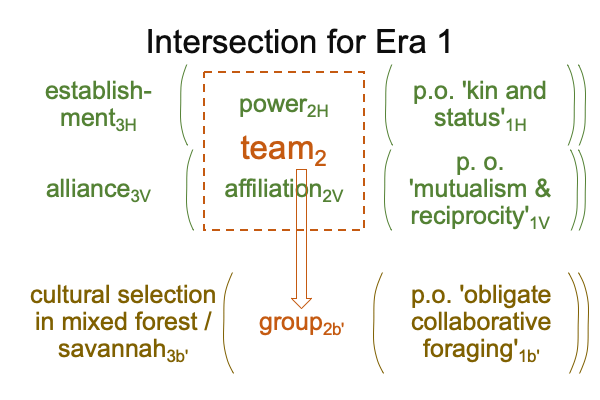0450 The era of joint intentionality begins with bipedalism as an adaptation to a changing environment and ecology. In eastern Africa, tropical forest gives way to mixed forest and savannah. The individual “southern ape” is less likely to successfully forage alone. So, for some lineages, collaborative foraging offers an option. Then, it becomes a preferred option. Then, it becomes the only option.
The team2b is the group that is culturally selected for in the environment and ecology of mixed forest and savannah3boperating on the potential of ‘obligate collaborative foraging’1b.
0451 Here is how the era starts.

0452 Chapter three is titled, “Second-Person Morality”.
0453 Here, a key insight from British anthropology comes into play, as delineated in Comments on Clive Gamble, John Gowlett and Robin Dunbar’s Book (2014) Thinking Big (by Razie Mah, available at smashwords and other e-book venues). With speciation to Australopithecus (transliterated “southern ape”), bipedalism frees the hands and enslaves the feet. The feet do the walking. The hands do the talking. At this point in hominin evolution, adaptations into the niche of triadic relations enter into the picture.
Social circles differentiate. Love and affection characterizes family (5) and intimate friends (5). Joint attention and shared intentionality typifies teams (15). Teams are the active agents for obligate collaborative foraging. Avoidance of predation underlies bands (50).
0454 What does that imply?
The groups of interest for the era of individual intentionality are family (5), intimate friends (5) and band (50).
The group that is of interest in the era of joint intentionality is the team (15).
0455 I ask, “Is a team2b the intersection of power2H and affiliation2V?”
Yes, and no.
Yes, if the meanings of the words change.
No, if the meanings of the words remain the same.
0456 According to Tomasello, second-person morality develops as “you” and “me” act in concert as a “we” (team). “We” have the motivations and skills required to pursue a joint goal, guided by shared intentions. Joint attention structures individual perceptions of others’ actions. Joint attention calls for judgment. Habitual perceptions and judgments define “roles” in team activities.
0457 Roles are not pre-defined slots, arranged into organizational charts. “Roles” label recurring patterns of habitual perceptions and judgments of one’s teammates. These perceptions and judgments are in flux. However, they tend to fall into a stable pattern, making accommodation easier. Individuals with perceptions and judgments that cannot be accommodated by other team-members are not invited to participate in team actions.
Say what?
0458 Hominins compete to cooperate.
0459 A team is a web of you-me relationships that perform as a single agent towards a single goal. Power2H and affiliation2V are bound to a social contract that appears present to a disinterested observer, but cannot be pictured or pointed to by the hand-talking participants. Indeed, power2H and affiliation2V are explicit abstractions that paper over the living collaborative “we” in the slogan, “We work for food.”
0460 Do early hominins collaborate in joint-attention activities for purely practical reasons?
Surely, “we”, this web of “you-me” relationships, with each “me” accommodating each “you” in order to say… gather much more food than any one of us could gather alone, cannot possibly be… may I say it?… fun?
0461 Practical reasons dictate that each “you-me” relationship is powered by productivity2H.
At the same time, fraternal enjoyment dictates that each “you-me” relationship is affiliated with a certain savoir faire. Having fun2V is more than getting along2V.
